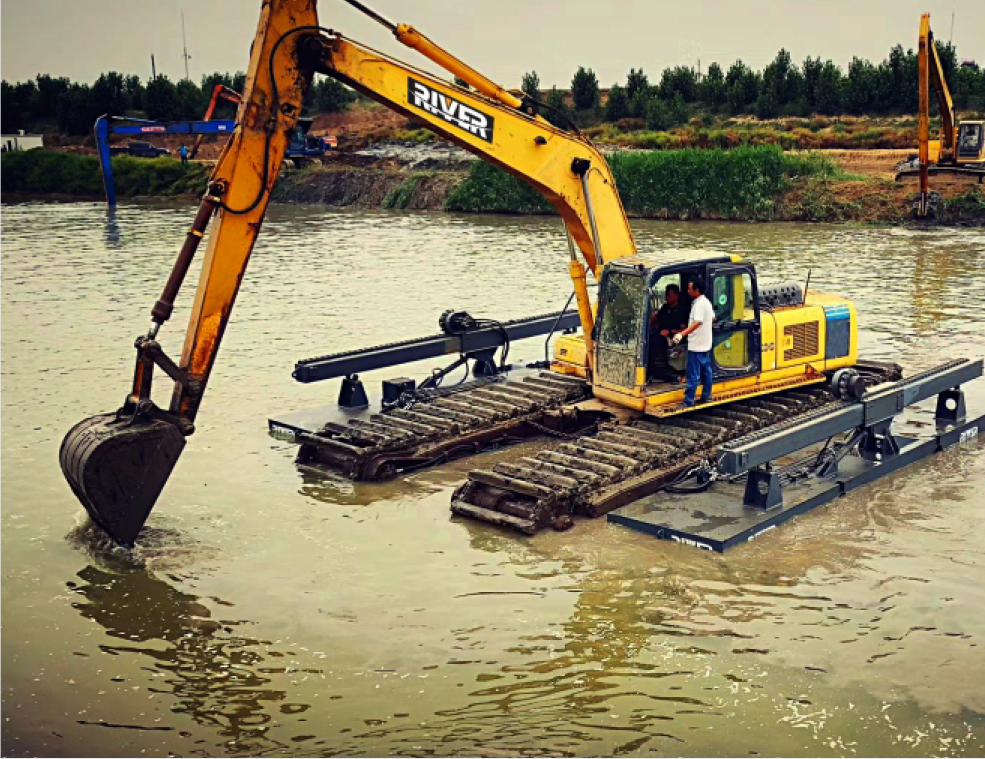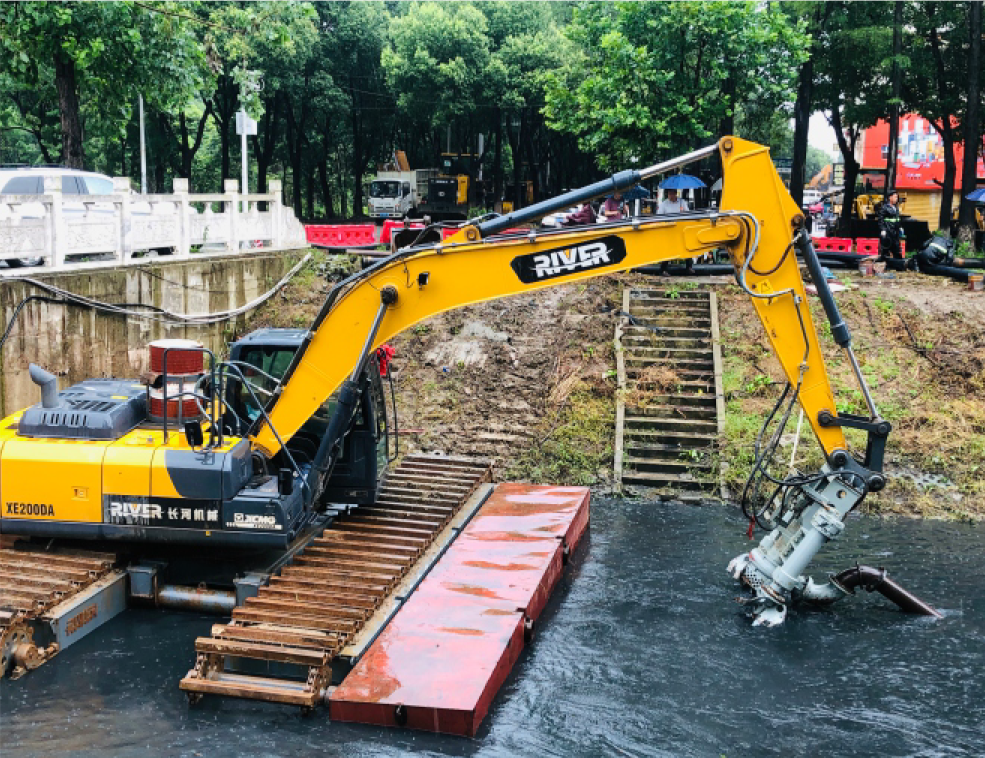An amphibious undercarriage is a type of construction machinery specifically designed to provide mobility to heavy equipment over challenging terrains such as wetlands, marshes, and shallow water areas. Choosing the right amphibious undercarriage is essential for ensuring optimal performance and efficiency in amphibious operations.
This decision involves considering various factors such as vehicle compatibility, load capacity, terrain adaptability, maintenance requirements, and cost considerations. By understanding these key aspects and making informed choices, you can select an amphibious undercarriage that meets your specific project needs and enhances the versatility of your equipment for both land and water applications. In this guide, we’ll help you choose the best amphibious undercarriage according to your requirements.
What Is an Amphibious Undercarriage?
An amphibious undercarriage is a modular framework that augments construction machinery with the capability to operate in both terrestrial and aquatic settings. It typically comprises a set of large, hollow pontoons that provide buoyancy, coupled with a robust drive system that facilitates movement across various surfaces.
Construction machinery equipped with amphibious undercarriage benefits from increased versatility, allowing it to undertake projects in environments that standard equipment would not be able to navigate. This innovation broadens the scope of possible construction and excavation tasks, particularly in areas subject to flooding or with abundant waterways.
BUY AMPHIBIOUS UNDERCARRIAGE HERE
Why Use an Amphibious Undercarriage?
Amphibious undercarriages are employed when tasks demand construction machinery to operate in areas with water or unstable soil. The undercarriage provides flotation and mobility, allowing heavy machinery to perform in conditions that would otherwise impede or damage standard equipment.
Innovative Technology
Investing in an amphibious excavator means putting money into a vehicle steeped in innovation. This advanced dredge undercarriage makes a proverbial splash as it barges through canals, allowing an excavator to float and operate with precision. Its supplementary construction features enhance an amphibious excavator’s ability to tackle a myriad of wetland industrial pump applications.
Sealed Pontoons
Amphibious excavators are equipped with sealed pontoons, designed to navigate shallow waters while remaining seawater-resistant. These pontoons are constructed from high-tensile steel and incorporate a hydraulic direct drive track system, ensuring durability and reliable propulsion in aquatic environments.
Environment Friendly
Amphibious undercarriages reduce the environmental impact of construction in sensitive areas. By minimizing ground pressure and disturbance, these machines operate where overhead costs are astronomical for traditional construction methods, offering a greener alternative for project completion.
BUY AMPHIBIOUS UNDERCARRIAGE HERE
Industrial Applications of Amphibious Undercarriage
Amphibious undercarriages have revolutionized how construction projects approach challenging environments. As essential machinery in the construction industry, these amphibious equipment pieces make previously inaccessible areas viable for development and repair. An amphibious excavator investment can expand a company’s operational capabilities and project scope significantly.
From infrastructure maintenance to ecological conservation, amphibious undercarriages enable machinery to work effectively on, in, or around bodies of water. Utilizing this specialized equipment translates to fewer project limitations and a broader range of services that construction companies can offer their clients.
Underwater Excavation
Amphibious excavators are particularly suited for underwater excavation. Their buoyancy and stability allow for precise digging and material removal, even in challenging aquatic conditions.
River Dredging
Amphibious undercarriages equipped with a dredge pump attachment can perform river dredging, clearing silt and debris to maintain navigable waterways and mitigate flooding risks.
Wetland Restoration
Amphibious undercarriages are invaluable in wetland restoration projects. They allow machinery to work in wet environments without causing significant disruption to the delicate ecosystem.
Bridge Repair and Installation
For bridge repair and installation tasks, amphibious undercarriages offer the necessary stability and access, ensuring safe and efficient work in and around water.
Construction of Drainage Systems
They are crucial for constructing drainage systems in areas with high water tables or prone to flooding, providing a stable platform for equipment to operate from.
Landscaping
Amphibious undercarriages also find their use in landscaping projects near water bodies, where they facilitate the transport and use of heavy machinery without damaging the terrain.
BUY AMPHIBIOUS UNDERCARRIAGE HERE
Choosing the Right Amphibious Undercarriage
Choosing the right amphibious undercarriage involves carefully considering the specific requirements of the construction equipment and the environment in which it will operate. Factors such as the need to purchase updated models, the pontoon undercarriage’s load capacity, and the terrain’s characteristics—including whether it is too dense for floating or too soft for reliable land-based operations—must be evaluated. The following is a detailed guide on how to choose the right amphibious undercarriage:
Excavation Depth and Distance
When selecting an amphibious undercarriage, the excavation depth and distance are critical factors to consider. The undercarriage must be capable of handling the project’s specific depth requirements, ensuring the excavator can reach and extract materials effectively. Additionally, the undercarriage should be designed to traverse the distance to the excavation site, whether it’s through muddy wetlands, shallow waters, or uneven terrain.
Adaptability to varying depths and distances influences the efficiency and productivity of the construction machinery. Proper assessment of these parameters ensures the amphibious undercarriage aligns with project needs, enabling continuous operation without compromising the safety and integrity of the equipment or the environment.
Vehicle Compatibility
When selecting an amphibious undercarriage, ensuring compatibility with the existing fleet is crucial. The undercarriage must fit the specific model and make of the excavator or other construction equipment it will support. This ensures that the hydraulic and mechanical interfaces align properly, allowing for seamless operation in wet environments. Compatibility not only affects performance but also impacts the safety of operations.
Manufacturers offer a range of undercarriages designed to pair with various brands and sizes of excavators and dredging machinery. Prior to purchase, verifying the compatibility specifications is a must to avoid costly modifications or the risk of equipment mismatch that could hinder project efficiency and effectiveness.
Cost and Budget
Cost considerations play a pivotal role in the decision-making process for acquiring an amphibious undercarriage. The price of these specialized undercarriages varies significantly, depending on their size, capacity, and features. It’s important to balance the initial investment against the potential increase in productivity and the ability to access previously unreachable areas.
Budget allocations should also factor in long-term operational costs, including maintenance and potential upgrades. Investing in a higher-quality undercarriage may result in lower lifetime costs, despite a higher upfront price, contributing to a more cost-effective operation over time.
Load Capacity
The load capacity of an amphibious undercarriage is a critical factor, as it determines the weight of the equipment and materials that can be safely transported and operated. It is imperative to select an undercarriage that can handle the demands of specific projects, whether it involves heavy lifting or transferring sizable quantities of earth in excavation or dredging tasks.
Overloading an amphibious undercarriage can lead to equipment failure and pose serious safety risks. Therefore, understanding the weight limitations and ensuring adherence to them is essential for maintaining the integrity and longevity of the undercarriage and the safety of the crew.
Cutter Suction Pump
The inclusion of a cutter suction pump in an amphibious undercarriage enhances its functionality, particularly for dredging operations. This pump allows for the excavation and removal of sediment, vegetation, and debris, making it a valuable asset in maintaining waterways and wet environments.
When choosing the right amphibious undercarriage, it is necessary to assess the capability and compatibility of the cutter suction pump with the project’s requirements. The pump’s power and efficiency dictate how effectively it can perform in various conditions, impacting overall project success.
Terrain Adaptability
Amphibious undercarriages must be adept at navigating diverse terrains, especially in environments that standard excavators cannot handle. The design of the undercarriage should allow for a smooth transition from solid ground to soft terrain, including marshy areas or shallow water. Terrain adaptability is vital for minimizing the environmental impact and ensuring the stability of the equipment.
Features such as multi-synchronous hydraulic drive systems and adjustable pontoons can significantly enhance the amphibious undercarriage’s ability to adapt to different terrain types. These systems provide the necessary traction and buoyancy to operate efficiently on both land and water.
Bucket
The bucket is a crucial component of amphibious excavation, directly influencing the efficiency of digging and material handling. Choosing the right bucket size and type is dependent on the specifics of an amphibious excavator’s operation, such as the density of the material and the required excavation depth.
Buckets with specialized designs, such as those with teeth optimized for penetrating rough surfaces or smooth edges for dredging, can greatly affect the performance of the amphibious undercarriage. To maximize productivity, it is essential to select a bucket that matches the project’s needs.
Level of Excavator
The level of the excavator refers to the machine’s size, power, and capabilities. When pairing with an amphibious undercarriage, it’s important to consider whether to purchase updated models or utilize existing construction equipment. The model of amphibious undercarriage chosen should correspond to the excavator’s operational level to ensure efficient and effective use.
A high-level excavator equipped with an appropriately robust amphibious undercarriage is necessary for heavy-duty tasks in particularly challenging environments. Conversely, a standard excavator may suffice for less demanding tasks, provided it aligns with the amphibious undercarriage’s specifications.
Maintenance Requirements
Maintenance is a critical aspect of owning an amphibious undercarriage, as regular upkeep ensures the longevity and reliability of the equipment. The complexity of maintenance can vary, but it typically includes inspections of the pontoons, hydraulic systems, and structural integrity. Adherence to a maintenance schedule can preemptively address wear and tear, preventing costly downtime and repairs.
Potential owners should assess the ease of access to maintenance points and the availability of replacement parts. An undercarriage that is designed with maintenance in mind can significantly reduce the time and cost associated with keeping the equipment in optimal condition.
Optional Support Elements
Beyond the standard features of an amphibious undercarriage, there are optional support elements that can enhance its performance. Auxiliary tools such as spud systems for stabilization, side pontoons for additional buoyancy, and winches for towing can be crucial for certain projects, offering improved versatility and capability.
When determining the necessity of these optional elements, it’s important to consider the nature of the projects they will be used for. Assessing the benefits versus the additional costs will guide decision-makers in tailoring the amphibious undercarriage to specific operational needs, ensuring a well-equipped and efficient fleet.
BUY AMPHIBIOUS UNDERCARRIAGE HERE
Wrap-Up!
Choosing the right amphibious undercarriage is a significant decision that can impact the success of heavy-duty tasks such as underwater excavation and bridge repair. The cutter suction dredger is particularly indispensable for river dredging, while the amphibious pontoon provides support across varying terrains. By considering these elements, one can develop the foundational knowledge to wisely invest and effectively meet the demands of challenging environments.


